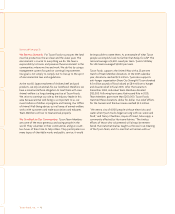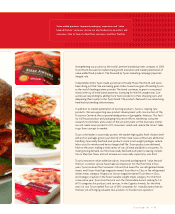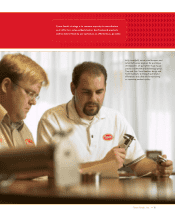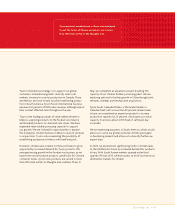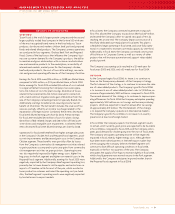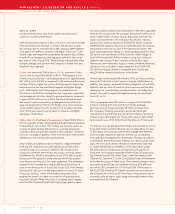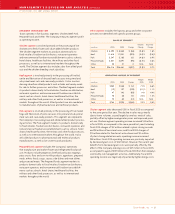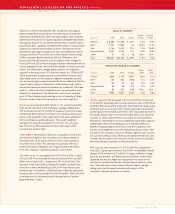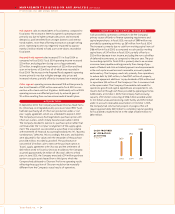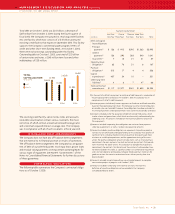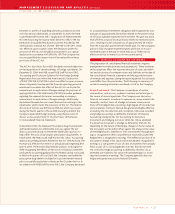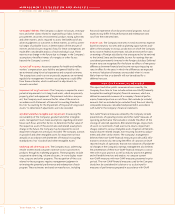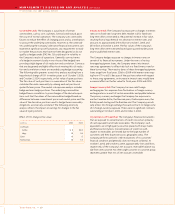Tyson Foods 2005 Annual Report Download - page 22
Download and view the complete annual report
Please find page 22 of the 2005 Tyson Foods annual report below. You can navigate through the pages in the report by either clicking on the pages listed below, or by using the keyword search tool below to find specific information within the annual report.
>> MANAGEMENT’S DISCUSSION AND ANALYSIS (CONTINUED)
TYSON FOODS, INC. 2005 ANNUAL REPORT
Tyson Foods, Inc. >> 20
2005 VS. 2004
Certain reclassifications have been made to prior periods to
conform to current presentations.
Sales decreased $427 million or 1.6%, with a 0.7% increase in average
sales price and a 2.3% decrease in volume. The decrease in sales
was primarily due to reduced sales in the Company’s Beef segment,
resulting from the effects of import and export restrictions. Addi-
tionally, sales were negatively impacted by decreased sales volumes
in each of the Company’s protein segments, primarily due to one
less week of sales in fiscal 2005. These declines were partially offset
by higher average sales prices in the Company’s Chicken, Pork and
Prepared Foods segments.
Cost of sales decreased $276 million or 1.1%. As a percent of sales,
cost of sales increased from 92.8% to 93.3%. The decrease in cost
of sales was primarily due to decreased grain costs of approximately
$312 million in fiscal 2005 as compared to the same period last year,
partially offset by higher live costs in the Pork segment, higher raw
material costs in the Prepared Foods segment and higher energy
costs. Additionally, the Chicken segment recorded losses of
$27 million in fiscal 2005 resulting from the Company’s commodity
risk management activities related to grain purchases as compared
to gains of $127 million in fiscal 2004. The fiscal 2004 gains were
due in part to grain commodity risk management activities that
were not designated as SFAS No. 133 hedges. Also, lower domestic
cattle supplies and restrictions on imports of Canadian cattle for
most of the year caused lower production volumes and higher
operating cost per head.
Selling, general and administrative expenses increased $48 million or
5.5%. As a percent of sales, selling, general and administrative expenses
increased from 3.3% to 3.6%. The increase was primarily due to an
increase of approximately $28 million in corporate advertising
expenses, which was primarily related to the Company’s “Powered
by Tyson” campaign. In addition, there were increases in personnel-
related costs and contributions and donations.
Other charges included $33 million related to a legal settlement
involving the Company’s live swine operations and $14 million
in plant closing costs, primarily related to the closings of the
Company’s Cleveland Street Forest, Mississippi, Portland, Maine,
and Bentonville, Arkansas, operations. In July 2005, the Company
announced it had agreed to settle a lawsuit which had resulted
from the restructuring of its live swine operations. The settlement
resulted in the Company recording an additional $33 million of
costs in the third quarter of fiscal 2005. In July 2005, the Company
announced its decision to make improvements to one of its Forest,
Mississippi, facilities, which will include more product lines,
enabling the plant to increase its production of processed and
marinated chicken. When the project is complete, the Company
will close the Cleveland Street Forest, Mississippi, poultry opera-
tion and transfer production and employees to the newly upgraded
facilities. Also in July 2005, the Company announced its decision to
close its Bentonville, Arkansas, facility. The production from this
facility was transferred to the Company’s Russellville, Arkansas,
poultry plant, where an expansion enabled the facility to absorb
the Bentonville facility’s production. In December 2004, the Company
announced its decision to close its Portland, Maine, facility. The
plant ceased operations February 4, 2005, and the production from
this facility was transferred to other locations. Other charges in
fiscal 2004 included $40 million in plant closing costs, primarily
related to the closings of the Company’s Jackson, Mississippi,
Manchester, New Hampshire, Augusta, Maine, and Berlin, Maryland,
operations. Also included in other charges for fiscal 2004 were
$25 million in charges related to intangible asset impairments
and $21 million related to fixed asset write-downs.
Interest expense decreased $48 million or 17.5%, primarily resulting
from an 8.7% decrease in the Company’s average indebtedness. In
addition, the Company incurred $13 million of expenses in fiscal 2004,
related to the buy back of bonds at attractive prices and the early
redemption of Tyson de Mexico preferred shares. Excluding these
charges, the overall weighted average borrowing rate decreased
from 7.4% to 7.1%.
Other expense decreased $5 million as compared to fiscal 2004,
primarily resulting from improvements in foreign exchange
gain/loss activity of approximately $9 million, primarily from
the Company’s Canadian operations, and an $8 million gain
recorded in fiscal 2005 from the sale of the Company’s remaining
interest in Specialty Brands, Inc. These items were partially offset
by increased losses of $13 million from the disposal of fixed assets.
The effective tax rate decreased from 36.6% in fiscal 2004 to 33.1% in
fiscal 2005. The fiscal 2005 effective rate was reduced by 4.1% due
to the release of income tax reserves that management deemed
were no longer required. In addition, the rate was increased by
4.2% relating to the repatriation of earnings of foreign subsidiaries
as allowed by the American Jobs Creation Act, offset by 2.9% relat-
ing to the reversal of certain international tax reserves that were
no longer needed due to the effects of the repatriation under
the American Jobs Creation Act. During the fourth quarter of
fiscal 2005, the Company repatriated $404 million of foreign earn-
ings invested outside the United States under the American Jobs
Creation Act. See Note 17 to the Consolidated Financial Statements
for further discussion of these issues. The estimated Extraterritorial
Income Exclusion (ETI) amount reduced the fiscal 2005 effective
tax rate by 2.6% compared to 0.5% in fiscal 2004. The increase in
the fiscal 2005 estimated ETI benefit resulted from an increase in
the estimated fiscal 2005 profit from export sales primarily due to
increased profit on export sales, along with an adjustment to the
estimated fiscal 2004 benefit.


